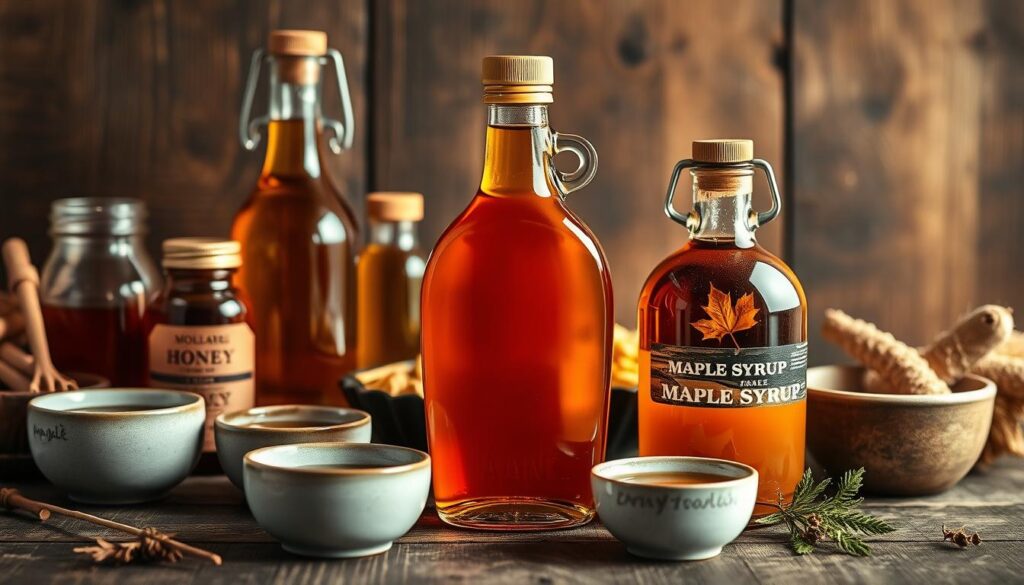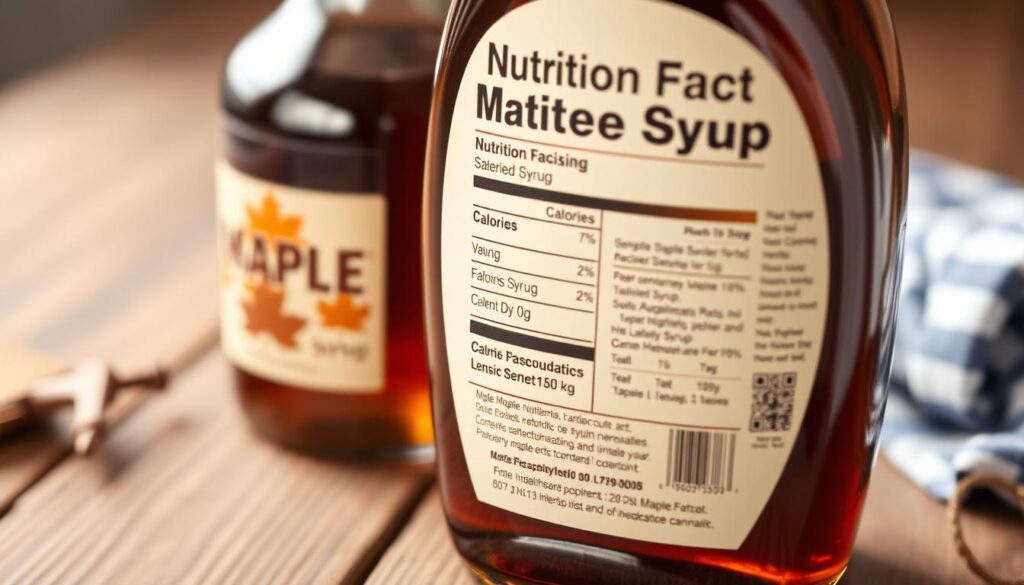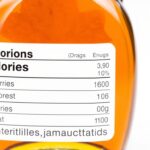Maple syrup is a natural sweetener that many people prefer over refined sugar. It’s a topic of interest for those who care about their health. Experts and food lovers alike are curious about its nutritional benefits.
Pure maple syrup is not just empty calories. It’s packed with minerals, antioxidants, and trace elements. This makes it different from regular sugar. People in places like Vermont and Quebec have known about its special qualities for a long time.
Research is showing that maple syrup might have some health benefits. It’s not a magic food, but it has nutritional perks. Its natural and minimally processed nature makes it a good choice for those watching their diet.
This guide will explore maple syrup’s nutrition, health effects, and how it compares to other sweeteners. You’ll learn about the science behind it. And how to use it in a healthy way.
Maple syrup is more than a topping for pancakes. It’s rich in minerals and has antioxidants. The process of making it is a tradition that’s interesting to many around the world.
Understanding Pure Maple Syrup: From Tree to Table
Maple syrup is a journey of natural change, capturing the essence of North American forests. It’s a sweet, nutrient-rich liquid. The pure Maple Syrup advantages start with its unique production process. This process turns tree sap into a delicious and nutritious sweetener.
Traditional Harvesting Methods
Indigenous communities first made maple syrup centuries ago. They used traditional methods like:
- Identifying mature maple trees during late winter
- Cutting small incisions in tree bark
- Collecting sap using wooden spouts and buckets
- Boiling sap over open wood fires
Modern Production Techniques
Today, maple syrup production has evolved with new technologies. The best Maple Syrup for health comes from well-managed forests. These forests use advanced collection systems.
- Vacuum-assisted sap collection
- Reverse osmosis concentration
- Precision evaporation equipment
- Automated monitoring systems
Grades and Classifications
Maple syrup is sorted by color, flavor, and light transmission. Grades range from Golden Color Delicate Taste to Very Dark Color Strong Taste. Each grade has its own taste and nutritional benefits.
| Grade | Color | Flavor Profile |
|---|---|---|
| Golden | Light | Mild, Delicate |
| Amber | Medium | Rich, Smooth |
| Dark | Deep | Robust, Intense |
Each grade shows maple syrup’s natural complexity. This lets consumers pick the perfect syrup for their taste and nutritional needs.
The Nutritional Profile of Maple Syrup
Maple syrup is more than just sweet. It’s packed with nutrients that go beyond its taste. It’s not just empty calories. It’s a treasure trove of essential nutrients for a healthy diet.
The nutritional breakdown of maple syrup is quite interesting:
- Carbohydrates: About 13 grams per tablespoon
- Calories: Around 52 per tablespoon
- Zero fat and minimal protein content
What makes maple syrup special is its rich mineral content. A single serving is full of nutrients that boost health. It’s loaded with:
- Manganese (supports bone health)
- Zinc (boosts immune function)
- Calcium (promotes strong bones)
- Potassium (regulates heart function)
“Nature’s sweetest gift isn’t just about flavor, but about nutritional value,” says nutritional expert Dr. Emily Roberts.
Maple syrup’s benefits go beyond its nutrients. It’s full of antioxidants that protect cells. Studies show it has up to 24 different antioxidants, making it better than refined sugars.
Even though maple syrup should be used sparingly, it’s a healthier choice. Its natural origins and nutrients make it a better option for those looking for a sweetener.
Essential Minerals and Vitamins in Maple Syrup
Maple syrup is more than just a sweet topping. It’s a natural superfood packed with essential minerals. These minerals are key to its health benefits.
Looking into its nutritional profile shows why maple syrup is special. Its rich mineral content makes it a unique natural sweetener. It offers health benefits that other sweeteners don’t.
Manganese and Zinc: Powerhouse Minerals
Maple syrup is a top source of manganese. This mineral is vital for bone health and metabolism. A single serving gives you:
- Approximately 30% of daily manganese requirements
- Support for enzyme production
- Assistance in bone formation
Calcium and Potassium Levels
Maple syrup’s mineral content goes beyond manganese. It also has important electrolytes for the body:
- Calcium for strong bones and teeth
- Potassium for heart and muscle health
- Regulatory support for cellular processes
Trace Minerals Present
Maple syrup also has trace minerals that add to its nutritional value. Zinc, copper, and magnesium are present in smaller amounts. Each plays a unique role in supporting health.
These minerals make maple syrup a better choice than refined sugars. It adds more than just sweetness to your diet.
Antioxidant Properties and Health Benefits

Maple syrup is a standout superfood, full of antioxidants that boost health. Studies show it has special compounds that fight oxidative stress in our bodies.
Maple syrup’s health perks go beyond its tasty taste. Scientists found several antioxidant groups in it. These groups offer big nutritional benefits:
- Phenolic compounds that neutralize free radicals
- Protective molecules that reduce cellular damage
- Natural inflammation-fighting ingredients
Researchers from the University of Rhode Island found 24 different antioxidants in pure maple syrup. These natural defenders help protect cells and boost immune function.
“Maple syrup offers more than just sweetness – it’s a nutritional powerhouse with remarkable protective properties.” – Dr. Helen Martinez, Nutrition Researcher
Maple syrup has more antioxidants than other sweeteners:
| Sweetener | Antioxidant Concentration | Health Potencial |
|---|---|---|
| Maple Syrup | High | Excellent |
| Honey | Medium | Good |
| Refined Sugar | Low | Minimal |
Even though maple syrup should be eaten in small amounts, its antioxidants make it a better choice than other sweeteners.
Is Maple Syrup Healthy? Breaking Down the Facts
Understanding maple syrup’s health effects needs a careful look. It has some good points but also things to watch out for. Knowing the maple syrup nutrition facts is important for those who care about their health.
Blood Sugar Impact
Maple syrup’s glycemic index is worth noting for blood sugar watchers. It has minerals that might slow down sugar absorption. Studies show it has a lower glycemic impact than white sugar.
- Glycemic Index: Approximately 54 (compared to 60-65 for white sugar)
- Contains natural compounds that may help regulate blood sugar
- Slower absorption rate than refined sweeteners
Caloric Content Analysis
Is Maple Syrup Healthy for calorie intake? It has similar calories to other sweeteners. Experts say to eat it in moderation for a balanced diet.
| Serving Size | Calories | Sugar Content |
|---|---|---|
| 1 Tablespoon | 52 calories | 13.4 grams |
| 1/4 Cup | 208 calories | 53.6 grams |
Daily Recommended Intake
Nutrition experts advise on sugar limits, including maple syrup. The American Heart Association says men should have no more than 36 grams of added sugar daily, and women no more than 25 grams.
- Limit maple syrup to 1-2 tablespoons per day
- Use as an occasional sweetener
- Balance with a nutrient-rich diet
Maple syrup has some health benefits but should be eaten with care. Its natural origin and minerals make it better than refined sugars. But, it’s important to eat it in moderation for the best health.
Comparing Maple Syrup to Other Sweeteners

Exploring Maple Syrup vs. sugar opens up a world of sweetener options. Natural maple syrup is unique, with nutritional benefits that traditional sugars don’t have.
Nutritional comparisons show big differences between maple syrup and other sweeteners:
- Refined sugar has empty calories with no health benefits
- Maple syrup has minerals like manganese and zinc
- Artificial sweeteners don’t have maple syrup’s natural profile
Maple syrup is more than just sweet. It has minerals and antioxidants, unlike white sugar. These can help with health.
| Sweetener | Calories per Tablespoon | Mineral Content |
|---|---|---|
| Maple Syrup | 52 | High in Manganese |
| White Sugar | 49 | No Minerals |
| Honey | 64 | Trace Minerals |
The glycemic index of maple syrup is interesting. It affects blood sugar but has a richer nutritional profile than refined sugars.
Sugarmakers suggest using maple syrup in moderation for a balanced diet. It’s seen as a healthier sweetener option.
Organic vs. Conventional Maple Syrup
More and more people are looking for organic maple syrup for their health. Organic and conventional maple syrup differ in more than just how they’re made.
Organic maple syrup is made with care for the environment. Producers follow strict rules to keep forests healthy and protect wildlife. This ensures that the syrup is safe for us to eat.
Certification Standards
Organic maple syrup producers must follow strict rules:
- No synthetic pesticides or chemicals in forest management
- Sustainable forest preservation practices
- Documented traceability of syrup production
- Regular third-party inspections
Environmental Impact
Maple syrup production affects the environment. Organic methods help keep forests healthy and support many species.
| Aspect | Conventional Maple Syrup | Organic Maple Syrup |
|---|---|---|
| Forest Management | Potential chemical interventions | Natural ecosystem preservation |
| Ecosystem Protection | Limited wildlife considerations | Comprehensive biodiversity support |
| Carbon Footprint | Higher environmental impact | Less strain on the environment |
By choosing organic maple syrup, you help the environment. It might also be better for your health.
Best Ways to Use Maple Syrup in a Healthy Diet
Adding maple syrup to your diet needs careful thought and creative cooking. It’s not just sweet; it also has health benefits when used right.
Maple syrup is a better choice than refined sugars in many diets. Experts say to use it sparingly to add flavor and health perks.
- Breakfast options: Drizzle small amounts over Greek yogurt or oatmeal
- Baking substitutions: Replace sugar with maple syrup at a 3:4 ratio
- Smoothie enhancement: Add a teaspoon for natural sweetness
- Salad dressing ingredient: Create unique vinaigrettes
It’s important to control how much maple syrup you use. Aim for 1-2 tablespoons a day to enjoy its health benefits without too much sugar.
| Meal Type | Maple Syrup Usage | Portion Size |
|---|---|---|
| Breakfast | Yogurt topping | 1 teaspoon |
| Baking | Sugar replacement | 3/4 cup per cup of sugar |
| Smoothies | Natural sweetener | 1-2 tablespoons |
Nutrition experts advise mixing maple syrup with protein to avoid blood sugar spikes. This makes it a better choice for a healthy diet.
Maple syrup isn’t just a sweetener—it’s a nuanced ingredient that can support a balanced, health-conscious diet when used thoughtfully.
Potential Health Risks and Considerations
Maple syrup has many health benefits, but knowing its risks is important. Is Maple Syrup Healthy? It depends on how you use it and your health.
Maple syrup is full of sugar, which is something to think about. This is key for people with certain health issues.
Sugar Content Concerns
People with metabolic problems need to be careful with maple syrup. It can raise blood sugar levels. This might affect:
- Blood sugar regulation
- Weight management
- Insulin sensitivity
Moderation is important for those watching their sugar intake.
Allergies and Sensitivities
Maple syrup allergies are rare but can happen. Symptoms might include:
- Mild skin irritations
- Respiratory symptoms
- Digestive discomfort
People with tree pollen allergies should be careful. They should talk to a doctor before trying maple syrup.
Awareness and individual health considerations are key when adding new foods to your diet.
Maple Syrup in Different Dietary Plans

Maple syrup is a great choice for those following different diets. It fits well into many nutritional plans. People looking for healthy sweeteners will find it useful.
Those on the Paleo diet like maple syrup. It’s a natural sweetener that’s not as processed as regular sugar. It also has a lower glycemic index.
- Vegan-friendly natural sweetener
- Gluten-free and dairy-free option
- Minimally processed ingredient
For low-carb dieters, maple syrup should be used in small amounts. Moderation is important to keep the diet balanced. Nutritionists suggest using it sparingly.
Keto dieters can use maple syrup during their carb windows. It’s a better choice than processed sugars for some diets.
Natural sweetness meets nutritional consciousness with maple syrup’s diverse dietary applications.
People with dietary restrictions should talk to doctors before adding new foods to their diet.
Storage and Shelf Life Guidelines
Storing maple syrup right is key to keeping its health benefits. Knowing how to store it well lets you enjoy it for a long time.
Temperature is very important for keeping maple syrup fresh. You can store unopened syrup in a cool, dark place for up to a year. After opening, keep it in the fridge to stop spoilage and keep its nutrients.
- Room temperature storage: Up to 1 year (unopened)
- Refrigerated storage: 1-2 years
- Freezer storage: Indefinite preservation
Sugarmakers suggest certain ways to keep maple syrup at its best:
- Always use clean, airtight containers
- Keep away from direct sunlight
- Avoid temperature fluctuations
- Check for crystallization or mold signs
Pro tip: If crystallization occurs, gently warm the syrup to restore its smooth consistency.
Proper storage is key to maintaining the natural goodness of pure maple syrup.
Maple syrup’s long shelf life makes it a great choice for those who care about their health. It’s a natural sweetener with real nutritional value.
Sustainable Production and Environmental Impact
Maple syrup production is a special mix of farming and caring for the environment. It’s not just tasty, but also deeply committed to keeping our planet safe and healthy.
The maple syrup world is key in saving our forests. Sugarmakers know that strong forests are vital for making pure Maple Syrup. This creates a win-win situation for both making syrup and protecting nature.
Forest Conservation Strategies
- Selective tree tapping that minimizes forest damage
- Maintaining forest biodiversity
- Protecting maple tree habitats
- Implementing responsible harvesting techniques
Carbon Footprint Considerations
Maple syrup making is very good for the environment. It has a much smaller carbon footprint than many other ways to make sweeteners.
| Production Aspect | Environmental Impact |
|---|---|
| Energy Consumption | Minimal fossil fuel usage |
| Forest Preservation | Active ecosystem maintenance |
| Carbon Sequestration | Maple forests absorb significant CO2 |
“Sustainable maple syrup production is not just about harvesting—it’s about preserving our natural heritage.” – Northeastern Forest Conservancy
Organic Maple Syrup benefits go beyond taste. It helps local ecosystems thrive. Sugarmakers are like guardians, protecting maple forests for all of us to enjoy in the future.
Choosing and Buying Quality Maple Syrup
Choosing the best maple syrup for health is important. It’s not just about sweetness. You need to know what makes top-quality syrup stand out.
When you’re looking for pure maple syrup, keep these tips in mind:
- Look for single-ingredient labels that list only maple syrup
- Check for USDA organic certification
- Examine the color and grade of the syrup
- Verify the source of production
Maple syrup grades tell you about quality and taste. The USDA has four main grades:
- Golden Color, Delicate Taste
- Amber Color, Rich Taste
- Dark Color, Robust Taste
- Very Dark Color, Strong Taste
“The purest maple syrup tells a story of traditional craftsmanship and natural goodness.” – Maple Syrup Producers Association
Pricing can show quality. Real pure maple syrup is pricier than fake stuff. You’ll spend $10-$20 for a 16-ounce bottle of the good stuff. Look for it at local farmers markets, specialty stores, and online.
Pro tip: Keep your maple syrup cool and dark. Refrigerate it after opening to keep its great taste and health benefits.
Conclusion
Looking into maple syrup’s health benefits shows it’s more than just a sweetener. It has unique nutrients, but it should be eaten in moderation. People wondering if maple syrup is healthy should know about its minerals and antioxidants.
Maple syrup has a rich nutritional profile. It’s packed with minerals like manganese and zinc. This makes it a better choice than refined sugars for those watching their diet.
Adding maple syrup to your diet needs careful thought. It’s important to control how much you eat and know how your body reacts. The best way to enjoy maple syrup is in small amounts, as part of a healthy diet rich in whole foods.
In the end, maple syrup is a natural sweetener with health benefits. How much you eat and why you choose it can make a big difference. It’s all about making smart choices and listening to your body.



